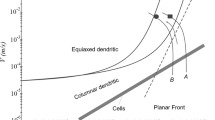Abstract
The results of studies showing the possibility of obtaining long products from composite ceramic nanomaterials by self-propagating high-temperature synthesis (SHS) extrusion have been presented, combining the combustion process of the initial components of the exothermic mixture and the high-temperature deformation of the combustion products. It is found that the production of nanoscale elements of the structure of the material is regulated by regime parameters of the technological process and a special choice of the initial composition of the initial exothermic mixture. The experimental results of studies of the microstructure and properties of the resulting nanostructured composite are discussed. The regularities of the influence of shear plastic deformation during the SHS extrusion on the microstructure and the size of the structural components of the synthesized ceramic composite have been studied in comparison with other methods: SHS without the application of external forces, free SHS compression, free SHS compression followed by quenching, and SHS pressing.
Similar content being viewed by others
References
I. P. Borovinskaya, Development Conception of Self-Propagating High-Temperature Synthesis as a Field of Scientific-Technical Progress (Territoriya, Chernogolovka, 2003), p. 178 [in Russian].
A. G. Merzhanov and A. S. Rogachev, Pure Appl. Chem. 64(7), 941 (1992).
A. P. Amosov, I. P. Borovinskaya, A. G. Merzhanov, and A. E. Sychev, “The way to control a dispersed structure of self-propagating high-temperature synthesis powders: beginning from monocrystalline grains up to nanosized particles,” Izv. Vyssh. Uchebn. Zaved. Tsvetn. Metallurg., No. 5, 9–22 (2006).
N. A. Azarenkov, A. A. Verevkin, and G. P. Kovtun, Foundations of Nanotechnologies and Nanomaterials (Kharkov, 2009) [in Russian].
Yu. S. Pogozhev, E. A. Levashov, A. E. Kudryashov, T.M. Ul’yanova, N. V. Dedov, and V. A. Matyukha, “The effect of refractory materials nanocrystalline powders onto burning, structure formation, phase composition and properties of TiC-TiAl based self-propagating high-temperature alloy,” Izv. Vyssh. Uchebn. Zaved. Tsvetn. Metallurg., No. 5, 23–31 (2006).
I. P. Borovinskaya, T. I. Ignat’eva, V. I. Vershinnikov, O. M. Miloserdova, and V. N. Semenova, “Self-propagating high-temperature ultra- and nanodispersed titanium carbide and wolfram carbide powders,” Poroshk. Metall., No. 9/10, 3–12 (2008).
Self-Propagating High-Temperature Synthesis: Theory and Practice (Territoriya, Chernogolovka, 2001) [in Russian].
I. P. Borovinskaya, Pure Appl. Chem. 64(7), 919 (1992).
A. G. Merzhanov and I. P. Borovinskaya, “Self-propagating high-temperature synthesis as a part of scientific technical progress,” in Development Concept of Self-Propagating High-Temperature Synthesis as a Field of Scientific Technical Progress (Territoriya, Chernogolovka, 2003), p. 14 [in Russian].
M. I. Alymov, Porous Metallurgy for Nanocrystalline Materials, Ed. by Yu. K. Kovneristyi (Nauka, Moscow, 2007) [in Russian].
P. M. Bazhin, A. M. Stolin, V. A. Shcherbakov, and E. V. Zamyatkina, “Nanocomposite ceramic produced by SHS extrusion,” Dokl. Chem. 430(2), 58 (2010).
A. G. Merzhanov, A. M. Stolin, V. V. Podlesov, L. M. Bu- chatskii, and T. N. Shishkina, International Patent Application PCT/SU 88/00274 1988, Publication 90/07015 (1990).
A. M. Stolin, “SHS-extrusion of long components,” Int. J. Self-Propagation High-Temp. Synth. 1(1), 135 (1992).
D. Vallauri, V. A. Shcherbakov, A. V. Phitev, and F. A. Deorsola, “Study of structure formation in TiC-TiB2-MexOy ceramics fabricated by SHS and densification,” Acta Mater. 56/6, 1380–1389 (2008).
A. G. Merzhanov, I. P. Borovinskaya, V. I. Ponomarev, I. O. Khomeko, Y. V. Zanevskii, S. P. Chernenko, L. P. Smykov, and G. A. Cheremukhina, “Dynamic X-ray diffraction of phase formation during self-propagation high-temperature synthesis,” Dokl. Akad. Nauk 328, 72 (1992).
A. G. Merzhanov, E. B. Pis’menskaya, V. I. Ponomarev, and A. S. Rogachev, “Dynamic X-ray crystallography of phase transformation in synthesis of intermetallic compounds under thermal explosion conditions,” Dokl. Phys. Chem. 363(1–3), 381–384 (1998).
L. M. Buchatskii and A. M. Stolin, “Porous materials deformation under non-isothermal conditions,” Plast. Massy, No. 9, 22 (1991).
T. N. Shishkina, A. M. Stolin, and V. V. Podlesov, “The influence of SHS production methods used on the material structure formation,” Int. J. Self-Propagation High-Temp. Synth. 4(1), 35 (1995).
R. Z. Valiev, Y. Estrin, Z. Horita, T. G. Langdon, M. J. Zehetbauer, and Y. T. Zhu, “Producing bulk ultrafine-grained materials by severe plastic deformation,” J. Minerals Met. Mater. Soc. (JOM) 58(4), 33–39 (2006).
R. Valiev, “Materials science: nanomaterial advantage,” Nature 419(6910), 887–889 (2002).
V. V. Podlesov, A. V. Radugin, A. M. Stolin, and A. G. Merzhanov, “Technological basis of SHS extrusion,” Int. J. Self-Propagation High-Temp. Synth. 63(5), 525 (1992).
I. P. Borovinskoi, “Promising materials,” in Development Conception of Self-Propagating High-Temperature Synthesis as a Field of Scientific-Technical Progress (Territoriya, Chernogolovka, 2003), pp. 178–182 [in Russian].
P. M. Bazhin, A. M. Stolin, and V. V. Sarantsev, “Formability of composite nanoceramics,” Zh. Vopr. Sovr. Nauki Praktiki Univ. im. V. I. Vernadskogo, No. 43, 51–56 (2012).
S. N. Galyshev, P. M. Bazhin, A. M. Stolin, and A. E. Sychev, “The way to synthesize Ti-Al-C based metal ceramics under conditions of free self-propagating high-temperature synthesis,” Perspekt. Mater., No. 2, 81 (2010).
A. M. Stolin, P. M. Bazhin, and R. V. Khairulina, “The way to use self-propagating high-temperature synthesis extrusion for producing composite nanoceramics,” Perspekt. Mater., No. 2, 77–82 (2012).
Author information
Authors and Affiliations
Corresponding author
Additional information
Original Russian Text © P.M. Bazhin, A.M. Stolin, M.I. Alymov, 2014, published in Rossiiskie Nanotekhnologii, 2014, Vol. 9, Nos. 11–12.
Rights and permissions
About this article
Cite this article
Bazhin, P.M., Stolin, A.M. & Alymov, M.I. Preparation of nanostructured composite ceramic materials and products under conditions of a combination of combustion and high-temperature deformation (SHS extrusion). Nanotechnol Russia 9, 583–600 (2014). https://doi.org/10.1134/S1995078014060020
Received:
Accepted:
Published:
Issue Date:
DOI: https://doi.org/10.1134/S1995078014060020




